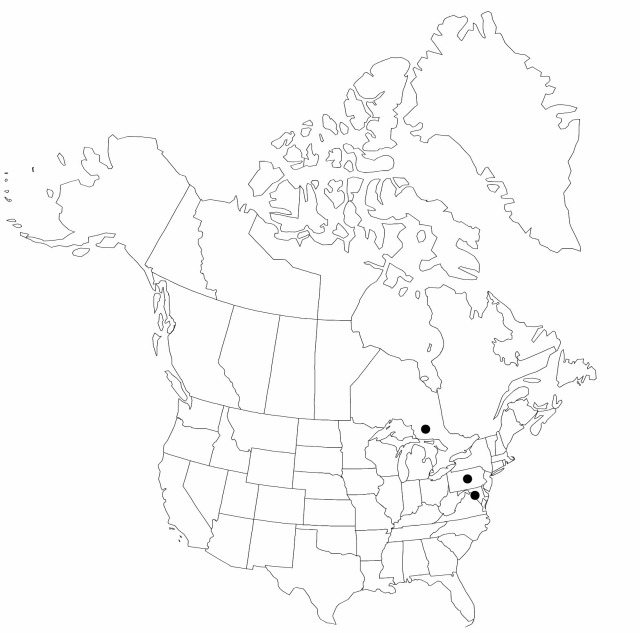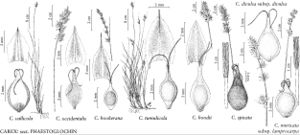Difference between revisions of "Carex divulsa subsp. divulsa"
FNA>Volume Importer |
imported>Volume Importer |
||
| Line 3: | Line 3: | ||
|accepted_authority= | |accepted_authority= | ||
|publications= | |publications= | ||
| + | |special_status={{Treatment/ID/Special_status | ||
| + | |code=I | ||
| + | |label=Introduced | ||
| + | }}{{Treatment/ID/Special_status | ||
| + | |code=F | ||
| + | |label=Illustrated | ||
| + | }} | ||
|basionyms= | |basionyms= | ||
|synonyms={{Treatment/ID/Synonym | |synonyms={{Treatment/ID/Synonym | ||
| Line 23: | Line 30: | ||
|elevation=10–200 m | |elevation=10–200 m | ||
|distribution=Ont.;D.C.;Pa.;Europe;w Asia. | |distribution=Ont.;D.C.;Pa.;Europe;w Asia. | ||
| + | |introduced=true | ||
|discussion=<p><i>Carex divulsa</i> subsp. leersii (Kneucker) Walo Koch (<i>Carex</i> leersii F. W. Schultz, not Willdenow) has been reported from eastern North America. All the specimens appear to be best accommodated in <i></i>subsp.<i> divulsa</i>, although they may differ slightly from the above description.</p><!-- | |discussion=<p><i>Carex divulsa</i> subsp. leersii (Kneucker) Walo Koch (<i>Carex</i> leersii F. W. Schultz, not Willdenow) has been reported from eastern North America. All the specimens appear to be best accommodated in <i></i>subsp.<i> divulsa</i>, although they may differ slightly from the above description.</p><!-- | ||
--><p><i>Carex divulsa</i> and <i>C. muricata</i> are part of a taxonomically difficult complex native in Europe and western Asia, which has been variously treated as consisting of several distinct species or as a single species with up to four infraspecific taxa. The treatment here is based on that by A. O. Chater (1980), who recognized two species each with two subspecies.</p> | --><p><i>Carex divulsa</i> and <i>C. muricata</i> are part of a taxonomically difficult complex native in Europe and western Asia, which has been variously treated as consisting of several distinct species or as a single species with up to four infraspecific taxa. The treatment here is based on that by A. O. Chater (1980), who recognized two species each with two subspecies.</p> | ||
| Line 47: | Line 55: | ||
|publication title= | |publication title= | ||
|publication year= | |publication year= | ||
| − | |special status= | + | |special status=Introduced;Illustrated |
| − | |source xml=https:// | + | |source xml=https://bibilujan@bitbucket.org/aafc-mbb/fna-data-curation.git/src/bb6b7e3a7de7d3b7888a1ad48c7fd8f5c722d8d6/coarse_grained_fna_xml/V23/V23_500.xml |
|genus=Carex | |genus=Carex | ||
|section=Carex sect. Phaestoglochin | |section=Carex sect. Phaestoglochin | ||
Revision as of 21:34, 27 May 2020
Plants without conspicuous rhizomes. Culms 25–90 cm, 1.8–3 mm wide basally, 0.8–1 mm wide distally. Leaves: sheaths tight, green, fronts hyaline; ligules to 2 mm, shorter than wide; widest leaf blades 2–3 mm wide, often papillose adaxially. Inflorescences with 4–8 spikes, 5–18 cm × 6–10 mm; proximal internodes 20+ mm, usually more than 2 times as long as proximal spikes; proximal bracts 1–4 cm; spikes with 3–12 spreading perigynia. Pistillate scales hyaline or pale brown with green, 3-veined center, ovate-elliptic, 2.8–3.7(–4) × 1.3–2.6 mm, body as long as perigynium, apex acute to short-awned. Anthers 1.5–1.9 mm. Perigynia pale yellow, finally dark brown to black, usually to 11-veined abaxially, 3.5–5.5 × (1.7–)2–2.6 mm, margins serrulate distally; beak 0.8–1.5 mm, apical teeth 0.3–0.6 mm. Achenes elliptic-ovate, 2.3–2.5 × 1.5–1.7 mm.
Phenology: Fruiting late spring–early summer.
Habitat: Fields, pastures, scrub, forest edges
Elevation: 10–200 m
Distribution

Introduced; Ont., D.C., Pa., Europe, w Asia.
Discussion
Carex divulsa subsp. leersii (Kneucker) Walo Koch (Carex leersii F. W. Schultz, not Willdenow) has been reported from eastern North America. All the specimens appear to be best accommodated in subsp. divulsa, although they may differ slightly from the above description.
Carex divulsa and C. muricata are part of a taxonomically difficult complex native in Europe and western Asia, which has been variously treated as consisting of several distinct species or as a single species with up to four infraspecific taxa. The treatment here is based on that by A. O. Chater (1980), who recognized two species each with two subspecies.
Selected References
None.
